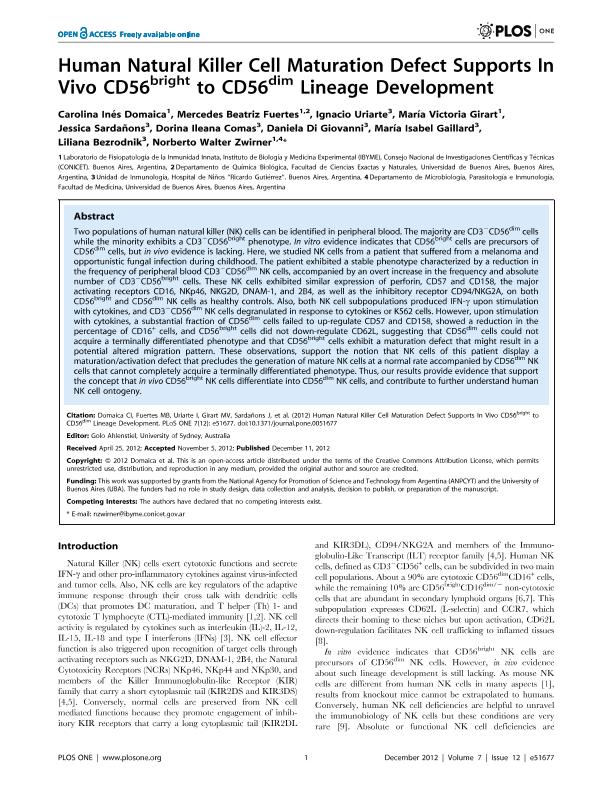Artículo
Human natural killer cell maturation defect supports in vivo CD56(bright) to CD56(dim) lineage development
Domaica, Carolina Ines ; Fuertes, Mercedes Beatriz
; Fuertes, Mercedes Beatriz ; Uriarte, Ignacio; Girart, Maria Victoria
; Uriarte, Ignacio; Girart, Maria Victoria ; Sardañons, Jessica ; Comas, Dorina Ileana ; Di Giovanni, Daniela ; Gaillard, María Isabel ; Bezrodnik, Liliana
; Sardañons, Jessica ; Comas, Dorina Ileana ; Di Giovanni, Daniela ; Gaillard, María Isabel ; Bezrodnik, Liliana ; Zwirner, Norberto Walter
; Zwirner, Norberto Walter
 ; Fuertes, Mercedes Beatriz
; Fuertes, Mercedes Beatriz ; Uriarte, Ignacio; Girart, Maria Victoria
; Uriarte, Ignacio; Girart, Maria Victoria ; Sardañons, Jessica ; Comas, Dorina Ileana ; Di Giovanni, Daniela ; Gaillard, María Isabel ; Bezrodnik, Liliana
; Sardañons, Jessica ; Comas, Dorina Ileana ; Di Giovanni, Daniela ; Gaillard, María Isabel ; Bezrodnik, Liliana ; Zwirner, Norberto Walter
; Zwirner, Norberto Walter
Fecha de publicación:
11/12/2012
Editorial:
Public Library Of Science
Revista:
Plos One
ISSN:
1932-6203
e-ISSN:
1932-6203
Idioma:
Inglés
Tipo de recurso:
Artículo publicado
Clasificación temática:
Resumen
Two populations of human natural killer (NK) cells can be identified in peripheral blood. The majority are CD3(-)CD56(dim) cells while the minority exhibits a CD3(-)CD56(bright) phenotype. In vitro evidence indicates that CD56(bright) cells are precursors of CD56(dim) cells, but in vivo evidence is lacking. Here, we studied NK cells from a patient that suffered from a melanoma and opportunistic fungal infection during childhood. The patient exhibited a stable phenotype characterized by a reduction in the frequency of peripheral blood CD3(-)CD56(dim) NK cells, accompanied by an overt increase in the frequency and absolute number of CD3(-)CD56(bright) cells. These NK cells exhibited similar expression of perforin, CD57 and CD158, the major activating receptors CD16, NKp46, NKG2D, DNAM-1, and 2B4, as well as the inhibitory receptor CD94/NKG2A, on both CD56(bright) and CD56(dim) NK cells as healthy controls. Also, both NK cell subpopulations produced IFN-γ upon stimulation with cytokines, and CD3(-)CD56(dim) NK cells degranulated in response to cytokines or K562 cells. However, upon stimulation with cytokines, a substantial fraction of CD56(dim) cells failed to up-regulate CD57 and CD158, showed a reduction in the percentage of CD16(+) cells, and CD56(bright) cells did not down-regulate CD62L, suggesting that CD56(dim) cells could not acquire a terminally differentiated phenotype and that CD56(bright) cells exhibit a maturation defect that might result in a potential altered migration pattern. These observations, support the notion that NK cells of this patient display a maturation/activation defect that precludes the generation of mature NK cells at a normal rate accompanied by CD56(dim) NK cells that cannot completely acquire a terminally differentiated phenotype. Thus, our results provide evidence that support the concept that in vivo CD56(bright) NK cells differentiate into CD56(dim) NK cells, and contribute to further understand human NK cell ontogeny.
Palabras clave:
Natural Killer Cells
,
Cd56
,
Maturation
,
Ontogeny
Archivos asociados
Licencia
Identificadores
Colecciones
Articulos(IBYME)
Articulos de INST.DE BIOLOGIA Y MEDICINA EXPERIMENTAL (I)
Articulos de INST.DE BIOLOGIA Y MEDICINA EXPERIMENTAL (I)
Citación
Domaica, Carolina Ines; Fuertes, Mercedes Beatriz; Uriarte, Ignacio; Girart, Maria Victoria; Sardañons, Jessica ; et al.; Human natural killer cell maturation defect supports in vivo CD56(bright) to CD56(dim) lineage development; Public Library Of Science; Plos One; 7; 12; 11-12-2012; 51677-51678
Compartir
Altmétricas



